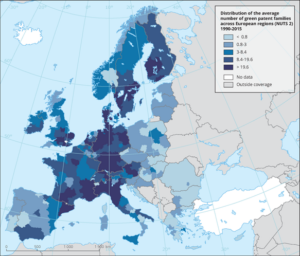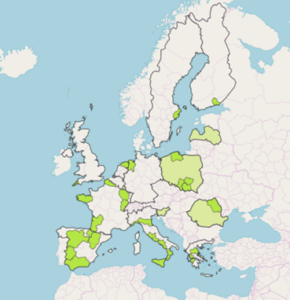This blog was written for the RSA Blog Student Summer Series that will highlight graduate student success in regional studies across the globe throughout the summer.
The Regional Studies Association’s Annual Conference saw Sandrine Kergroach chair Professor Riccardo Crescenzi, Oliver Harman and Anna Hammarberg for the Opening Plenary session. The following piece is a brief 650-word synopsis of why Green Global Value Chains (GGVCs) matter for sustainable regional development for the student summer blog series. The full plenary session to view is available here and the RSA Policy Impact Book underpinning the discussion here. For a short video explaining ‘What are Global Value Chains’, watch here.
Sustainable regional development can be achieved in many ways. Yet some approaches are more applicable than others, in particular when it comes to less developed regions. One approach is to focus on the development of frontier green technologies, such as innovative and carbon-neutral solutions. However, a key measure for the generation of these new technologies—green patents—shows that the generation of these technologies is highly concentrated in a few regions. In these regions, a limited number of leading firms—often multinationals—are responsible for most of these patents, indicating limited access to generation of these ‘new to the world’ technologies. This is shown in Figure 1 below. Thus, pursuing leading green knowledge may face challenges due to competition among regions and the need for large-scale firms. It may not be applicable for all regions, especially in less advanced ones.

Figure 1: The concentration of green patents in Europe (Source: European Environment Agency, 2020 using data from PATSTAT)
A second approach is to attract new green sectors to regions where they are lacking. Yet, many regions are already attempting this, often resulting in competition for the same industries (again often dominated by a limited number of multinational players). An example of this is highlighted in Figure 2 below that shows the many EU regions aiming to facilitate the development of a CO2 Capture and Storage within their boundaries. Moreover, producing certain green products requires sophisticated facilities and expertise. Thus, while attracting green industries is an option, it takes time and requires consideration of what other regions are doing. Not all regions may have this.

Figure 2: Regions with strategy over 2014 – 2020 (RIS-3) to attract CO2 Capture and Storage (Source: European Commission, via eye@RIS3 platform)
To counter the difficulties with green technologies and green sectors, Green Global Value Chains (GGVCs) provide a solution. This third and complementary strategy—one building on the approach of our Policy Impact Book—is to focus on greening existing products and services by reinforcing the green tasks pursued locally. By incorporating green practices and tasks into current regional capabilities, firms and workers can deliver existing goods—the ones in which the local economy has already consolidated strengths—in a more environmentally friendly manner. To aid in this strategies’ success, it is important to consider not only final products but also intermediate goods and services. These intermediate components play a significant and often overlooked role in the global production of goods and services. Thus, regions can tap into specific intermediate stages of the value chain and harness them (rather than trying to harness ‘full’ final products) to contribute to the green transition. As an example, a region does not need to aim at producing an entire electric bike in order to contribute to a goal of sustainable mobility. Rather it can, at lease initially, focus on a particular component or stage in the production chain where existing local capabilities can offer some sort of competitive advantage. In doing so, this third approach incorporates both green upgrading within the value chain and thus local sustainability.
There are distinct ways in which regions facilitate this green upgrading. Horizontal upgrading is one form, where regions enhance their capabilities within the industry by producing more sophisticated components. For example, a region that produces standard bicycle brakes can upgrade to manufacturing electric bicycle brakes. Vertical upgrading is another form. This involves moving up the value chain by specialising in more advanced tasks, for example moving from producing standard bicycle brakes to designing them, and potentially in a less environmentally damaging way. In short, by focusing on tasks rather than sectors, regions can identify opportunities for sustainable development.
By embracing GGVCs and integrating sustainability into regional strategies, regions can diversify their policies and create new opportunities for inclusive and sustainable development. To leverage GVCs, it is crucial to focus on tasks within the value chain, upgrade within existing industries, and incorporate greener practices throughout the entire value-added process. By doing so, regions can contribute to the global green transition while enhancing their own economic growth and development.

Oliver Harman is a Cities Economist for the International Growth Centre’s (IGC) Cities that Work initiative based at Blavatnik School of Government, University of Oxford and Associate Staff at Department of Geography and Environment, London School of Economics. He is also a Clarendon Scholar studying (part time) DPhil in Sustainable Urban Development at University of Oxford. Oliver is co-author of the recent RSA Policy Impact book Harnessing Global Value Chains for regional development.

Riccardo Crescenzi (Twitter: @crescenzi_r) is a Professor of Economic Geography at the London School of Economics and Political Science (LSE), UK. He has been a European Research Council (ERC) grant holder, leading a major five-year research project on foreign direct investment (FDI), global value chains (GVCs) and their territorial impacts across the globe. He is currently the LSE Principal Investigator of a large collaborative research project funded by Horizon Europe and UK Research and Innovation (UKRI) on inequalities in the era of global megatrends. Riccardo has been a Jean Monnet Fellow at the European University Institute (EUI), a Visiting Scholar at the Taubman Centre at Harvard University, and at the University of California—Los Angeles (UCLA), as well as an Associate at the Centre for International Development (CID) at the Harvard Kennedy School of Government.
Are you currently involved with regional research, policy, and development? The Regional Studies Association is accepting articles for their online blog. For more information, contact the Blog Editor at rsablog@regionalstudies.org.